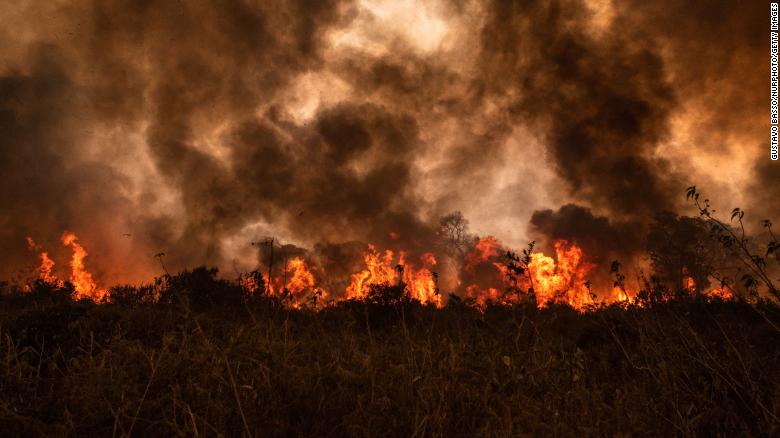SOURCE: CNN
DATE: November 13, 2020
SNIP: The world watched as California and the Amazon went up in flames this year, but the largest tropical wetland on earth has been ablaze for months, largely unnoticed by the outside world.
South America’s Pantanal region has been hit by the worst wildfires in decades. The blazes have already consumed about 28% of the vast floodplain that stretches across parts of Brazil, Bolivia and Paraguay. They are still not completely under control.
The fires have destroyed unique habitats and wrecked the livelihoods of many of the Pantanal’s diverse indigenous communities. But their damaging impact reaches far beyond the region.
Wetlands like the Pantanal are Earth’s most effective carbon sinks — ecosystems that absorb and store more carbon than they release, keeping it away from the atmosphere. At roughly 200,000 square kilometers, the Pantanal comprises about 3% of the globe’s wetlands and plays a key role in the carbon cycle.
When these carbon-rich ecosystems burn, vast amounts of heat-trapping gases are released back into the atmosphere, contributing to the greenhouse effect.
Brazil’s National Institute of Space Research (INPE) has detected more than 21,200 fires in the Pantanal biome so far this year, a figure that is already 69% higher than the full-year record from 2005, when INPE recorded roughly 12,500 fires. There were 8,106 fires in September alone — more than four times the historic average for the month.
The Pantanal’s distinctive habitats rely on what scientists call the “flood pulse.” During the wet season between November and March, three quarters of the plain gets flooded, only for much of the water to drain away during the dry months, from April to September. This seasonal flooding makes the Pantanal a unique biome where large swaths of land regularly turn from terrestrial into aquatic habitats and back again.
The area is home to thousands of endangered or unusual species, including jaguars, capybaras, black caimans, giant otters and hyacinth macaws. It’s also an important stop on the routes of around 180 species of migratory birds.
But this year’s dry season has been the most severe since the 1970s.
Extreme weather events, such as drought and floods, are becoming more frequent and more severe around the world, and the Pantanal is no exception. There are indications that the region is getting drier and warmer as the global temperatures rise.
While fires ignited by lightning sometimes occur naturally in the Pantanal, Larcher, who works for environmental NGO Instituto Homem Pantaneiro, said this year’s fires have mostly been caused by people. This is despite the Brazilian government’s ban on fires for 120 days in the Amazon and the Pantanal that was issued in July.
But Andre Luiz Siqueira, the CEO of ECOA, an environmental NGO based in the Brazilian state of Mato Grosso do Sul, said the ban wasn’t being enforced strictly enough. “There are extensive areas (where) livestock farmers have regularly used fire as a way to clear farm fields,” said Siqueira. “This year, even with the governmental ban … these producers set fire that ended up spreading for thousands of acres due to the great drought.”
As the global demand for agricultural products rises, so commercial farmers clear more of the Pantanal’s native vegetation for growing and grazing. Brazil is already the world’s leading exporter of beef. As the demand for meat rises around the world, so does deforestation in the Amazon.
Parts of the Pantanal have been designated a biosphere conservation area and recognized as a UNESCO World Heritage site, but overall, less than 5% of the region is under formal protection, according to the WWF. More than 90% is privately owned by ranchers, farmers and conservation groups, with 80% of that private land used for cattle farming, according to Brazil’s environment ministry.

